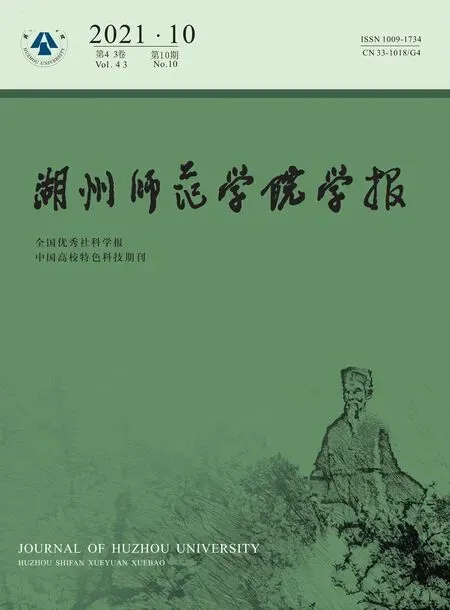Commuting Linear Maps on the Mirror Heisenberg-Virasoro Lie Algebra
LIANG Yue,LOU Jing,GAO Shoulan
(School of Science,Huzhou University,Huzhou 313000,China)
Abstract:Using the definition and the property of commuting linear map,we determine the general form of the commuting linear maps on the mirror Heisenberg-Virasoro Lie algebra and discuss some structure properties.On this basis,we further calculate the centroid of the mirror Heisenberg-Virasoro Lie algebra.
Keywords:mirror Heisenberg-Virasoro Lie algebra;commuting linear map;centroid
0 Introduction
The Heisenberg algebra and the Virasoro algebra are of great importance in many fields of mathematics and physics,which have many generalizations and extensions such as the twisted Heisenberg-Virasoro algebra[1-2],the generalized Heisenberg-Virasoro algebra[3],and the mirror Heisenberg-Virasoro algebra[4].These Lie algebras have been extensively studied.
Linear maps are important components in the structure theory of Lie algebras,such as derivations,homomorphisms,automorphisms and commuting linear maps.Commuting linear maps have closed relationship with the biderivations and the centroids.There are many researches on the commuting linear maps of Lie algebras,such as the commuting linear maps of finite dimensional Lie algebras[5],Kac-Moody algebras[6]and the deformed twisted Schrödinger-Virasoro Lie algebra[7].In addition,the centroid of a Lie algebra consists of special commuting linear maps,which is closely related to the derivation and the Poisson algebraic structure of the Lie algebra.Hence the centroids of Lie algebras have also been extensively studied,such as [8]~[10].In this paper,we calculate the commuting linear maps on the mirror Heisenberg-Virasoro Lie algebra,and then determine its centroid.
Throughout the paper,we denote by,the set of integers and the complex field,respectively.All the linear spaces are assumed over the complex field.
1 Preliminaries
Definition1[4]The mirror Heisenberg-Virasoro Lie algebra g as a linear space has a basis
with the following brackts:
[Lm,Ir]=-rIm+r,[Ir,Is]=rδr+s,0C2,[C1,g]=[C2,g]=0
for allm,n∈,r,s∈
Definition2[5]LetLbe a Lie algebra.A bilinear mapf:L→Lis called a commuting linear map of the Lie algebraLif
[x,f(x)]=0,∀x∈L.
For any commuting linear mapfof a Lie algebraL,it is easy to see that
[x,f(y)]=-[y,f(x)]=[f(x),y],∀x,y∈L.
Definition3[8]LetLbe a Lie algebra.The centroid ofLis
Cent(L)={φ∈End(L)|φ[x,y]=[φ(x),y],∀x,y∈L},
where End(L)is the set of linear transformations onL.
For anyφ∈Cent(L),since
φ[x,y]=-φ[y,x]=-[φ(y),x]=[x,φ(y)],
we have
[φ(x),y]=φ[x,y]=[x,φ(y)],∀x,y∈L.
Therefore,φ∈Cent(L)is a commuting linear map.
2 Commuting linear maps on the mirror Heisenberg-Virasoro Lie algebra
In this section,we determine the commuting linear mapfon the mirror Heisenberg-Virasoro Lie algebrag.
Theorem1For any commuting linear mapfon the mirror Heisenberg-Virasoro Lie algebrag,there exist somea,qm,pm,ur,λr,x,y,w,z∈such that
f(Lm)=aLm+qmC1+pmC2,
(1)
f(Ir)=aIr+urC1+λrC2,
(2)
f(C1)=xC1+yC2,
(3)
f(C2)=wC1+zC2
(4)
for allm∈,r∈Conversely,iffis a linear map ongsatisfying (1)~(4)for somea,qm,pm,ur,λr,x,y,w,z∈,thenfis a commuting linear map ong.
ProofLetfbe any commuting linear map on the mirror Heisenberg-Virasoro Lie algebrag.
(a)Form∈,assume
f(Lm)=∑amiLmi+∑brsIrs+qmC1+pmC2,
wheremi∈,rs∈.By

we haveami(m-mi)=0,brsrs=0. Sincers≠0,obviously,brs=0,andami=0 formi≠m.Hence
f(Lm)=amLm+qmC1+pmC2.
(5)
For anym,n∈,using (5),we have

Since [Lm,f(Ln)]=[f(Lm),Ln],we can obtainam=anform≠n.Then
am=a0,∀m∈.
Therefore,
f(Lm)=a0Lm+qmC1+pmC2,∀m∈.
(6)
(b)Forr∈assume
f(Ir)=∑cmiLmi+∑drsIrs+urC1+λrC2,
wheremi∈,rs∈andcmi,drs∈.According to
0=[Ir,f(Ir)]=[Ir,∑cmiLmi+∑drsIrs+urC1+λrC2]=∑cmirImi+r+∑drsrδr+rs,0C2=∑cmirImi+r+d-rrC2,
we havecmir=0,d-rr=0.Sincer≠0,we get
cmi=0,d-r=0.
Then
f(Ir)=∑drsIrs+urC1+λrC2,∀r∈
(7)
In addition,for anym∈,r∈using (6)and (7),we have
[Lm,f(Ir)]=[Lm,∑drsIrs+urC1+λrC2]=-∑drsrsIm+rs,[f(Lm),Ir]=[a0Lm+qmC1+pmC2,Ir]=-a0rIm+r.
Since [Lm,f(Ir)]=[f(Lm),Ir],we have ∑drsrsIm+rs=a0rIm+r,which suggests that
Clearly,drs=0 forrs≠r;dr=a0forrs=r.Hence
f(Ir)=a0Ir+urC1+λrC2,∀r∈
(8)
(c)For anyx∈g,
[x,f(Ci)]=[f(x),Ci]=0,i=1,2.
Sof(C1),f(C2)∈C1⊕C2.Together with (6)and (8),we have (1)~(4).
The converse part of the theorem is easy to check.The theorem holds.
Define linear maps
on the mirror Heisenberg-Virasoro Lie algebragas follows:
(9)
(10)
(11)
(12)
ψ1(Lm)=0,ψ1(Ir)=0,ψ1(C1)=C1,ψ1(C2)=0,
(13)
ψ2(Lm)=0,ψ2(Ir)=0,ψ2(C1)=C2,ψ2(C2)=0,
(14)
ψ3(Lm)=0,ψ3(Ir)=0,ψ3(C1)=0,ψ3(C2)=C1,
(15)
ψ4(Lm)=0,ψ4(Ir)=0,ψ4(C1)=0,ψ4(C2)=C2,
(16)
for allm∈,r∈Then we have the following properties.
Proposition1The linear maps

defined by (9)~(16)are commuting linear maps on the mirror Heisenberg-Virasoro Lie algebrag.
ProofIt is easy to check directly.

ProofAssume
wherea,x,y,w,z,qn,pn,us,λs∈.Then

Similarly,
σ(C1)=aC1+xψ1(C1)+yψ2(C1)=(a+x)C1+yC2,
σ(C2)=aC2+wψ3(C2)+zψ4(C2)=wC1+(a+z)C2.
Ifσ=0,thenσ(Lm)=0,σ(Ir)=0,σ(C1)=0,σ(C2)=0,which forces
a=x=y=w=z=qn=pn=us=λs=0.
It suggests that the proposition holds.
Proposition3For any commuting linear mapfon the mirror Heisenberg-Virasoro Lie algebrag,fis a linear combination of
ProofAccording to the calculation in Proposition 2,it is easy to see that the commuting linear mapfdefined as (1)~(4)in Theorem 1 can be written by
Hence the proposition holds.
By Proposition 1~3,we have the following result.
Theorem2The linear space,the set of all commuting linear maps on the mirror Heisenberg-Virasoro Lie algebrag,is infinite dimensional and has a basis
3 The centroid of the mirror Heisenberg-Virasoro Lie algebra
In this section,we determine the centroid of the mirror Heisenberg-Virasoro Lie algebrag.
Lemma1For anyφ∈Cent(g),there exist somea,x,y,w,z∈such that
φ(Lm)=aLm,φ(C1)=xC1+yC2,m∈,
(17)
φ(Ir)=aIr,φ(C2)=wC1+zC2,r∈
(18)
Conversely,ifφis a linear map ongsatisfying (17)~(18)for somea,x,y,w,z∈,then
φ∈Cent(g).
ProofLetφ∈Cent(g).Thenφis a commuting linear map ong.By Theorem 1,we can assume
φ(Lm)=aLm+qmC1+pmC2,φ(Ir)=aIr+urC1+λrC2,m∈,r∈
φ(C1)=xC1+yC2,φ(C2)=wC1+zC2.
Hence
Sinceφ[Lm,Ln]=[φ(Lm),Ln],we have
(19)
(m-n)qm+nC1+(m-n)pm+nC2=0,n≠-m.
(20)
By (19),we get

Obviously,
a=x,q0=p0=y=0.
(21)
Takingn=0 in (20),we haveqm=pm=0 form≠0.Using (21),we get
qm=pm=0,∀m∈.
(22)
By (21)and (22),we have
φ(Lm)=aLm,∀m∈.
(23)
On the other hand,
φ[Ir,L0]=rφ(Ir)=arIr+rurC1+rλrC2,[φ(Ir),L0]=[aIr+urC1+λrC2,L0]=-a[L0,Ir]=arIr.
For anyr∈sinceφ[Ir,L0]=[φ(Ir),L0],we haverur=0 andrλr=0,which forces
ur=0,λr=0,∀r∈
Therefore,
φ(Ir)=aIr,∀r∈
(24)
By Definition 3,it is easy to see thatφ(C1),φ(C2)∈C1⊕C2.Together with (23)~(24),we have (17)~(18).The converse part of the lemma is easy to check.
Proposition4The linear mapsψi(i=1,2,3,4)defined by (13)~(16)belongs to Cent(g).
ProofIt is easy to check directly.
According to the discussion above,we have the result about the centroid of the mirror Heisenberg-Virasoro Lie algebrag.
Theorem3Cent(g)=Id⊕ψ1⊕ψ2⊕ψ3⊕ψ4.

